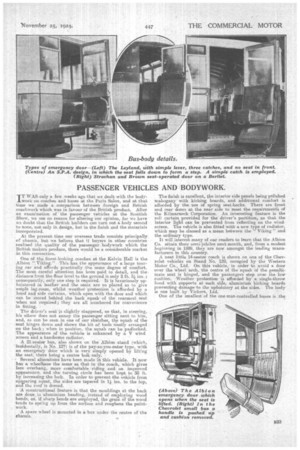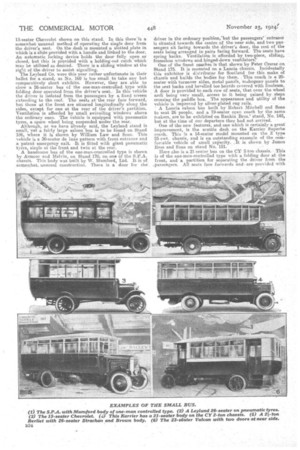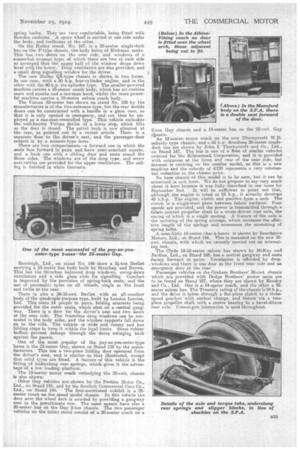PASSENGER VEHICLES AND BODYWORK.
Page 17

Page 18

Page 19

If you've noticed an error in this article please click here to report it so we can fix it.
PWAS only a few weeks ago that we dealt with the bodywork on. coaches and buses at the Paris Salon, and at that time we made a comparison between foreign and British
eaachwork which was in favour of the British product. After an exam:no:lien of the passenger vehicles at the Scottish Show, we see no reason for altering our opinion, for we have nu doubt that the British builders can turn out a body second to none, not only in design, but in the finish and the materials incorporated.
At the present time our overseas trade consists principally. of chassis, but we believe that if buyers in other countries realised the quality of the passenger bodywork which the British makers produce, there would be a considerable market in this connection.
One of the finest-looking coaches, at the Kelvin Hall is the Albion "Viking." This has the appearance of a large touring car and affords practically the same degree of comfart. The most careful attention has been paid to detail, and the distance from the floor level to the ground is only 2 ft, 5& ins. ; consequently, only one step is required. lb is luxuriously up holstered in leather 'and the seats are so placed as to give
ample 1 7roodn, whilst weather protection is afforded by a hood and side curtains, which open with, the door and which
can be stored behind the back squab of the rearmost seat when not required ; they are all numbered ibt convenience in fitting.
The driver's seat isslightly staggered, so that, in steering, his elbow does not annoy the passenger sitting next to him, and, as can be seen in one of our sketches, the squab of the seat hinges down and shows the kit of tools neatly arranged on the back ; when in position, the squab can be padlocked. The appearance of the vehicle is enhanced by a V wind screen and a handsome radiator.
A 21-seater bus, also shown an the Albion stand (which, inoldentally, is No. 127) is of the pay-as-you-enter type, with an emergency door which is very simply opened by lifting the seat, there being a centre bolt only. Several alterations have been mode in this vehicle. It now has a -wheelbase the same as that in the coach, which gives less overhang, more comfortable riding and an improved appearance, and the. burning circle has been kept to 50 ft. by increasing the lock. In order to prevent the vehicle from app;aaring squat, the sides are tapered in 14 ins, to the top, ana the roof is domed.
'A constructional feature is that the mouldings at the back are doue..iii aluminium beading, 'instead of employing wood bends, as, if sharp bends are employed, the grain of the wood tends to aping up from the surface and roughens the paint. work.
A spare wheel is mounted in a box under the centre of -the chassis. The finish is excellent, the interior side panels being polished mahogany with kicking boards, and additional comfort is afforded by the use of spring seat-backs. There are front and rear doors at the near side to meet the requirements of the Kilmarnock Corporation.. An interesting feature is the will curtain, provided for the driver's partition, so that the interior light can be prevented from reflecting on the windtereen. The vehicle is also fitted with a new type of radiator, which may be classed as a mean between the " Viking " and the ordinary type. It will interest many of our readers to learn that the Albion Co. attain their semi-jubilee next month, and, from a modest .beginning in 1889, they are now amongst the leading manu
facturers in this country. .
A neat little 14-seater coa,ah is shown on one of the Chevrolet vehicles on Stand No. 129, occupied by the Western Motor Co., Ltd. On this vehicle, in order to avoid a door over the wheel arch, the centre of the squab Of the penultimate seat is hinged, and the passengers step over the low cushion. Weather protection is afforded by a . single-throw hood with supports at each side, aluminium kicking boards preventing damage to the upholstery at, the sides. The body is one built by Vickers, Ltd.
One of the smallest•ef the one-man-controlled buses is the 13-seater Chevrolet shown on this stand. In this therels a somewhat unusual method of operating the single door from the driver's seat. On the dash is mounted a slotted plate in which is a slide provided with a handle and linked to the door. An automatic locking device holds the door fully open or closed, but this is provided with a holding-out catch which may be utilized as desired. There is a sliding window at the right of the driver to assist signalling.
The Leyland Co. were this year rather unfortunate in their ballot for a stand, as No. 169 is too small to take any but comparatively short exhibits. However, they are able to show a 26-seater bus of the one-man-controlled type with folding door operated from the driver's seat. In this vehicle the driver is isolated from the passengers by a fixed screen extending to the roof. The seats at-the rear face forward, hut those at the front are situated longitudinally along the sides, except for one at the rear of the driver's partition. Ventilation is afforded by small swivelling windows above the ordinary ones. The vehicle is equipped with pneumatic tyres, a spare wheel being suspended under the rear. Although, as we have already said, the Leyland stand is small, yet a fairly large saloon bus is to be found on Stand 186, where it is shown by William Law and SODS. This vehicle is a 30-seater de luxe pattern with front entrance and a patent emergency exit. It is fitted with giant pneumatic tyres' single at the front and twin at the rear.
A handsome bus of the one-man-controlled type is shown by Armour and Melvin, on Stand 170, on one of the S.P.A. chassis. This body was built by W. Mumford, Ltd. It is of. :somewhat. unusual construction. There is a door for the' driver in the ordinary position,'but the passengers' entrance is situated towards the centre of the near side, and two passengers sit facing towards the driver's door, the rest of the seats being arranged in pairs facing forward. The seats have spring backs. Ventilation is afforded by two-piece, sliding, frameless windows and hinged-down ventilators, One of the finest coaches is that shown by Peter Crerar on Stand 175. It is mounted on a Lancia chassis. Incidentally this exhibitor is d:stributor for Scotland for this make of chassis and builds the bodies for them. This coach is a 20seater with turnover sides, metal panels, mahogany panels to the seat backs and bevelled toe boards covered with linoleum. A door is provided to each row of seats, that over the wheel arch being very small, access to it being gained by steps crossing the paddle box. The appearance and utility of the vehicle is improved by silver-plated rug rails. A Lancia saloon bus built by Robert Mitchell and Sons to seat 26 people, and a 19-seater open coach by the same makers, are to be exhibited on Rankin Bros.' stand, No. 143, hut. at the time of our departure they had not arrived. One of the new features, and one which is certainly a great improvement, is the scuttle dash on the Karrier Superbe coach. This is a 14-seater model mounted on the Z type 25 cwt. chassis, and is an outstanding example of the comfortable vehicle of small capacity.. ,It is shown by James Ross and Sons on stand No. 151.
Here also is a 21.-seater bus on the CY 2-ton chassis. This is of the one-man-controlled type with a folding door at the front, and a partition for separating the driver front the .passengers. All seats face forwards and. are provided with spring backs. They are very comfortable, being fitted with Bowden cushions. A spare svheel is carried at one side under the body, and toolboxes at the other. On the Halley stand, No. 167, is a 30-seater single-deck bus on the P-type chassis, the body being of Hickman make. This has two doors on the near side, and windows of a somewhat unusual type, of which there are two at each side so arranged that the upper half of the window drops down level with the lower. Drop ventilators are also provided, and a saran drop signalling window for the driver. The new Halley QX-type chassis is shown in two forms. In one case, with a 30 h.p. four-cylinder -engine, and in the other with the 40 h.p. six-cylinder type. The smaller-powered machine carries a 19-seater coach body, which has air-cushion seats and squabs and a one-manhood, whilst the more powerful machine carries a 19-seater saloon coach body.
The 'Vulcan 23-seater bus shown on stand No, 128 by the manufacturers is of the taro-entrance type, but the rear double doors can be constructed with a handle in a glass case, so that it is only opened in emergency, and can thus be employed as a one-man-controlled type. This vehicle embodies the. well-known Vulaan device of a lower step, which lifts as the door is closed. The petrol tank is now situated at the rear, as pointed out in a recent article. There is a separate door to the driver's seat, and the passenger-door control is by a scissors-type lever. There are two compartments—a forward one in which the seats face forward in pairs and have semi-armchair squabs, and a back one with a sliding door and seats round the three sides. The windows are of the drop type, and screw anti-rattles are provided for the upper ventilators. The ceiling is finished in white lincrusta.
Rossleigh, Ltd., on stand No. 146 show a 4-ton Berliet carrying a 25-seater bus body built by Strachata and Brown. This has the Strachan balanced drop windows, swing-down ventilators and a side glass slide for signalling. Comfort is improved by the provision of spring-back seats and the use of pneumatic tyres on all wheels, single at the front and twins at the rear.
There is also a 30-35-cwt. Berliet with an all-weather body of the quadruple-purpose type, built by London Lorries, Ltd. This seats 14 people in pairs, folding armrests being provided for the outer seats, which abut on a central gangway. There is a door for the driver's seat and two doors at the near side. The frameless drop windows can be concealed in the body sides, and the window supports fall down on to the sills. The vehicle is wide and roomy and has folding steps to keep it within the legal limits. Stout rubber butlers prevent damage through the doors swinging back
against the panels.
One of the most popular of the pay-as-you-enter-type buses is the 25-seater Guy, shown on Stand 125 by the manufacturers. This has a two-piece folding door operated from the. driver's seat, and is similar to that illustrated, except that solid tyres are fitted. A feature of this vehicle is the fitting of undershing Tear springs, which gives it the advantage of a low loa,ciang platforma
The 18-seater motor coach embodying the 30-cwt, ehasis is also shown.
Other Guy vehicles are shown by the Peoblea Motor Co., Ltd., on Stand 145, and by the Scottish Commercial Cars Co,, Ltd., on Stand 149. The first-mentioned exhibit is a 20seater coach on the.speed model chassis. In this vehicle the door aver the wheel arch is avoided by providing a gangway seat. in the penultimate row. The same agents have also a 20-seater bus on the Guy 2-ton chassis. The two passenger vehicles on the latter stand consist of a 20-seater coach on a .2.ten Guy chassis and a 14-seater, bus on the 25-cwt. Guy chassis. 'An 18-seater motor coach on the new Thornycroft W.D. -subsidy type chassis, and a 35 h.p. Boadicea 30-seater singledeck bus We shown by John I. Thornyoroft and Co., Ltd., on Stand 147. The bus is One of a. fleet of similar vehicles ordered for the Kilmarnock Corporation, and it is provided with entrances at the front and rear of the near side, but Interest is centring on the smaller model, as this is a new machine and the subsidy of £120 represents a very sabstantial reduction in the chassis price.
No bare chassis of this model is to be seen, but it can he examined in unit form. We do not propose to say very much about it here because it was fully described in our issue for September 2nd. It will be sufficient to point out that, although the engine is rated at 25 h.p., it actually develops 40 b.h.p. The engine, clutch and gearbox kiln a unit. The clutch is a single-steel plate between fabric.; surfaces:. Four speeds are provided, and the power is transmitted through: a fabric-jointed propeller shaft to a worm-driven rear axle, the casing of which is is single casting. A feature of the axle is the inclining of the Spring stirrups, which increases the effective length of the springs and overcomes the stretching of spring bolts. A 'neat -littla 14-seater char-5,-hancri is shown by Beardmore Motors, Lida on Stand 165. , This is mounted on the new 30cwt. chassis, with which we recently carried out an interest
rug test. . The Clyde 14-18-seater saloon bus shown by McKay and Jardine. Ltd., on Stand 168, has a dentral gangway and seats facing forward in pairs Ventilation is afforded by drop_ windows and there is one door at the front near side and an emergency door at the rear.
Passenger vehicles on the graham Brothers' 30-cwt. chassis which are provided with Dodge Brothers' power units are to be found on Stand 187, where they are shown by Hendry and Co., Ltd. One is a 14-seater coach, and the other a 16seater saloon bus. The Treasury rating of the chassis is 24 h.p., and the drive ia taken thaough a flat-plate clutch to a threespeed gearbox with central change, and thence via a. twopiece propeller shaft with a centre bearing to a bevel-driven rear axle. Grease-gun lubrication is used throughout.


































